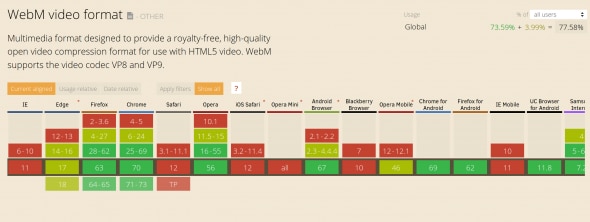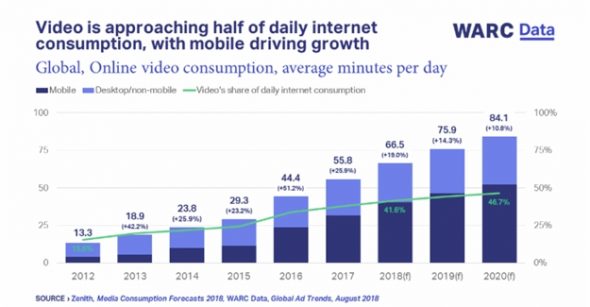Sign up to our Newsletter
Online video’s explosive growth has created tremendous new opportunities for engaging customers and developing new revenue streams. But despite the fact that video is becoming increasingly central to many online business strategies, many publishers still lack the tools and data to understand what factors are important in keeping their audiences engaged.
In the U.S., roughly 87% of Internet users now watch video online, consuming nearly 40 billion content videos and 10 billion video ads per month – totaling nearly 23 hours of video per viewer each month.
How One AI-Driven Media Platform Cut EBS Costs for AWS ASGs by 48%

Adding videos to your website can sometimes be a double-edged sword. Web users love high-resolution videos, but if your website isn’t optimized to handle them, such content can cause performance problems.
This article explains how to make sure your multimedia content is increasing conversions instead of driving away users.
Video performance optimization
Video optimization solutions enhance online viewing experiences for consumers and improve network utilization, thereby enabling cable operators and mobile carriers to handle surges in demand for high-resolution streaming digital media—and the bandwidth necessary to supply it.
With the ubiquity of high-speed internet access, the availability of OTT subscription streaming video services and the accessibility of premium content, more and more users are choosing to be entertained when they want, where they want, and from whatever device they choose. And despite the toll this inevitably takes on network infrastructures, consumers have come to expect more content and better video performance from online media services.
Implementing video optimization is one of the ways service providers are working to respond to consumer demand for instantaneous startup, smooth playback and superior video quality from start to finish.
Originally used in hotspots or areas of high congestion to provide interruption-free streaming of online content, video optimization techniques are increasingly being incorporated throughout networks due to the explosive growth in digital media consumption. Using video optimization protocols like HTTP live streaming that help reduce the amount of bandwidth consumed by a streaming session, service providers are able to offer exceptional quality video without having to spend unnecessarily on network expansion.
Thanks to their ability to pack high-quality videos into small file sizes, MP4 and WebM have become the standard formats for platforms like YouTube and Vimeo. MP4 videos are supported by all browsers while WebM is currently only fully supported by Chrome and Firefox.

The two-second rule
In an always-on world where users have been primed for instant gratification, speed matters. For websites, the impact of site performance on business metrics such as page views, conversion rates, and even user satisfaction has been well-documented.
Over the past decade, we’ve seen the “eight-second rule” – meaning users would abandon sites taking longer than 8 seconds to download – get slashed to the four seconds and then two, as user expectations have risen over time. Now, studies show that even 200 to 400 milliseconds can make a significant difference in Web applications.
That difference has clear business implications: for e-commerce sites, for example, one extra second of page-load delay can translate into millions of dollars of lost sales revenue each year.
One might expect that start up delays have a similar impact on abandonment of videos, and, indeed, the quantitative data shows that a similar two second threshold applies. Specifically, viewers will start abandoning a video if startup takes longer than two seconds to begin playing, and for every additional second of delay, roughly an additional 6% of the audience leaves.
This means having a fast startup time is critical for video. With a 5 second delay, a publisher may have lost a quarter of its audience, and with a 10 second delay, nearly half the audience has left. This means a few seconds of delay can cost a publisher millions in potential revenue, not to mention irreparable harm to the brand.

Improving online video performance for maximizing engagement
Good video performance plays a critical, causal role in decreasing abandonment, improving engagement, and increasing return viewership. Thus, video publishers that are looking to successfully build audiences and monetize their content need to look for a video delivery solution that helps them consistently achieve the performance quality and end user experience their viewers demand.
There are several key factors that are particularly relevant to achieving strong performance and a compelling user experience:
Highly distributed network
Two primary causes of poor video performance are network congestion and network latency occurring between the end user and the video’s origin server. Both factors increase as the distance and number of networks traversed increase. A highly distributed network minimizes these delays by delivering video streams from as close to the end user as possible – often from right within the user’s own ISP. This greatly reduces
errors, packet loss, and other delays, allowing for fast video startup and the best possible playback quality.
A highly distributed network also offers the greatest scalability and reliability. Distributed nodes provide tremendous fault tolerance even in the face of large-scale network failures, and they provide the ability to easily absorb demand from flash crowds and large-scale events without performance degradation.
Adaptive bitrate streaming
Adaptive bitrate streaming enables end users to experience faster video startup times and reduced or eliminated rebuffering delays while enjoying the highest-quality video viewing experience possible. In essence, each viewer’s video stream bitrate adapts in real time to performance conditions like network latency, available bandwidth, and even local device processing capability. If packet loss occurs midstream, the video stream drops to a lower bitrate until conditions improve, avoiding a video freeze up or rebuffering delay.
In addition, videos can start up faster and seek faster, by starting at lower bitrates and smoothly transitioning to higher bitrates, delivering the best quality video while preventing abandonment from impatient viewers.
Sophisticated media analytics
Just as important as the delivery infrastructure itself is the ability to measure and understand video performance metrics. Effective analytics solutions not only help content providers monitor their user experience and troubleshoot problem areas, but also optimize product portfolios, manage distribution strategies, and most importantly, understand the key factors in maximizing their online revenues.
Online video performance optimization for web pages
To increase performance, do this before adding videos to your website:
- Stream Directly From Your Server. In the dark ages of the internet, video files had to be fully downloaded to the user’s device before they could be viewed. Today, streaming technology allows videos to be delivered in small chunks that are ready for playback in the user’s browser. Medium has a helpful article that explains how to optimize video streaming on your website using HTML5 tags.
- Use a Content Delivery Network. A CDN is a network of servers that store cached copies of your site’s static assets. In addition to improving redundancy, CDNs ensure faster content delivery as the content is served from the nearest edge server. This is essential for large files such as videos. That way, users don’t have to wait forever for your videos to download and buffer. Using a CDN can drastically improve your website’s overall performance.
- Convert to HTML5 Supported Formats. A major advantage of HTML5 is that developers can now deliver video content without the aid of a plugin. Use an online video converter to convert your video files to HTML5 formats such as MP4 and WebM
Conclusion
Multimedia content can be the key to engaging and retaining users in modern business landscape. If you have any questions about media delivery and streaming solutions, contact us today to help you out.






